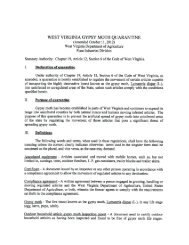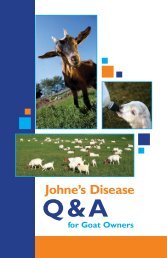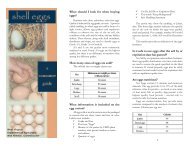Growing Grapes in WV - West Virginia Department of Agriculture
Growing Grapes in WV - West Virginia Department of Agriculture
Growing Grapes in WV - West Virginia Department of Agriculture
Create successful ePaper yourself
Turn your PDF publications into a flip-book with our unique Google optimized e-Paper software.
are wormy at harvest time. It is adark-colored caterpillar. It passesthe w<strong>in</strong>ter <strong>in</strong> the pupal stage onfallen leaves. It emerges about thetime the grapes are blossom<strong>in</strong>g.There are two broods. The first eatsthe stems and external portions <strong>of</strong>the young berries. The caterpillars<strong>of</strong> the second brood live entirely <strong>in</strong>the berries. They attack all cultivars.They are most <strong>in</strong>jurious to thosecultivars that have compact clusterss<strong>in</strong>ce they tend to be protected <strong>in</strong>such clusters and can feed readilyon more than one berry. Some<strong>of</strong> the <strong>in</strong>jured grapes fall from theclusters; the rest must be discardedat harvest time. Spray<strong>in</strong>g is the bestcontrol, but deep cultivation <strong>of</strong> theleaves <strong>in</strong> late fall or early spr<strong>in</strong>galso aids <strong>in</strong> control. For a few v<strong>in</strong>es,it <strong>of</strong>ten pays to pick and destroy theberries <strong>in</strong>fested by the spr<strong>in</strong>g broodand to rake and burn the leaves <strong>in</strong>the fall to reduce the overw<strong>in</strong>ter<strong>in</strong>gpopulation. Populations may bemonitored with a commercially availablepheromone trap. Trichogramam<strong>in</strong>utum Riley is an egg parasitethat will provide some biologicalcontrol.The rose chafer (Macrodactylussubsp<strong>in</strong>osus (Fabricius)) may bevery bad <strong>in</strong> some seasons, especiallywhere there is light, sandysoil nearby. It is a long-legged,yellowish-brown beetle about onethird<strong>in</strong>ch long. It may appear <strong>in</strong> vastswarms about the middle <strong>of</strong> June orearlier. It stays about a month andeats foliage <strong>of</strong> all k<strong>in</strong>ds <strong>in</strong> gardens,v<strong>in</strong>eyards and orchards. The larvaefeed on the roots <strong>of</strong> grasses <strong>in</strong> sandysoil. Consequently, if most <strong>of</strong> thesurround<strong>in</strong>g land is under cultivation,the number <strong>of</strong> chafers may bekept down. Cultivation also destroys-20-some <strong>of</strong> the pupae. Petal-fallsprays for grape berry moth willalso control rose chafers.The Japanese beetle(Popillia japonica (Newman))is a sh<strong>in</strong>y metallic-green beetleless than half an <strong>in</strong>ch long withcoppery-brown front w<strong>in</strong>gs. It is<strong>of</strong> considerable importance <strong>in</strong>parts <strong>of</strong> <strong>West</strong> Virg<strong>in</strong>ia. It usuallyappears between June 1 and 15,and may be present until mid-August or later. Grape leavesare among its favorite foods, andunless protected many <strong>of</strong> theleaves may be reduced to a lacelikeskeleton. The eggs are laid <strong>in</strong>the soil <strong>in</strong> grassy areas and thegrubs develop there. The larvaemay be controlled by a bacterium,Bacillus popillae (milkyspore). This biological controlagent is applied to grassy areasto control large larval populations,but is not effective aga<strong>in</strong>stadults. Commercially availableattractant traps are generally notadequate to protect v<strong>in</strong>eyards,but can be useful <strong>in</strong> monitor<strong>in</strong>gpopulations. Insecticide applicationswill usually be necessary forcontrol <strong>of</strong> the adults.The Grape root borer(Vitacea polistiformis (Harris))can cause extensive damage toa v<strong>in</strong>eyard before its presence iseven detected. Although <strong>in</strong>conspicuous,the larval feed<strong>in</strong>g canresult <strong>in</strong> yield losses and death<strong>of</strong> the v<strong>in</strong>es. The borers, whichare white with brown heads andrange <strong>in</strong> size from less than an<strong>in</strong>ch to two <strong>in</strong>ches, feed beneaththe outer bark <strong>of</strong> the roots. Theadults, unlike most moths, flyonly dur<strong>in</strong>g the day, and <strong>of</strong>ten escapeidentification because they

















